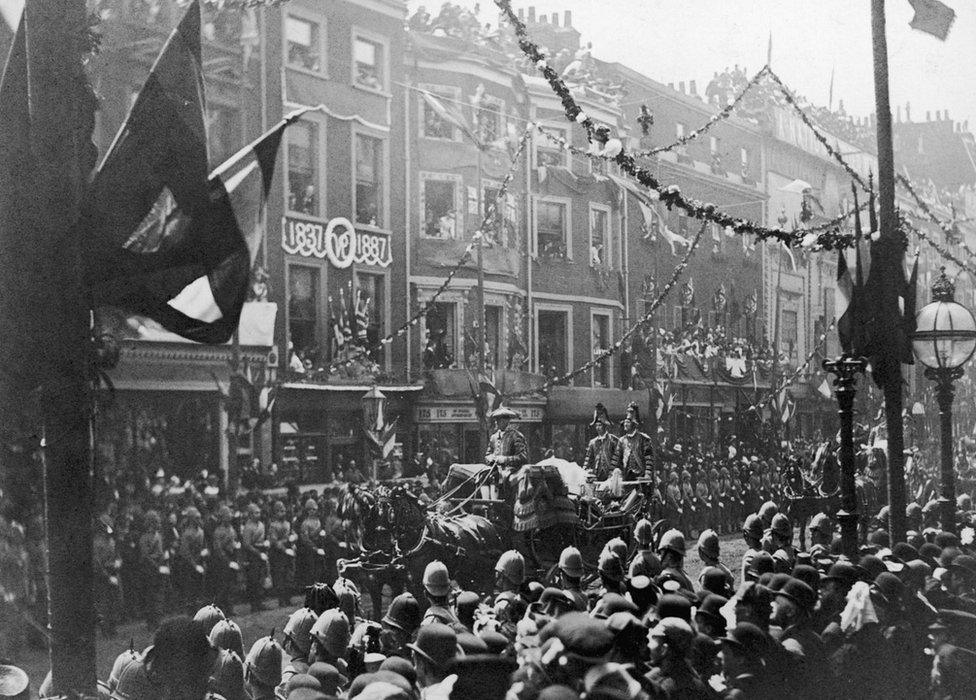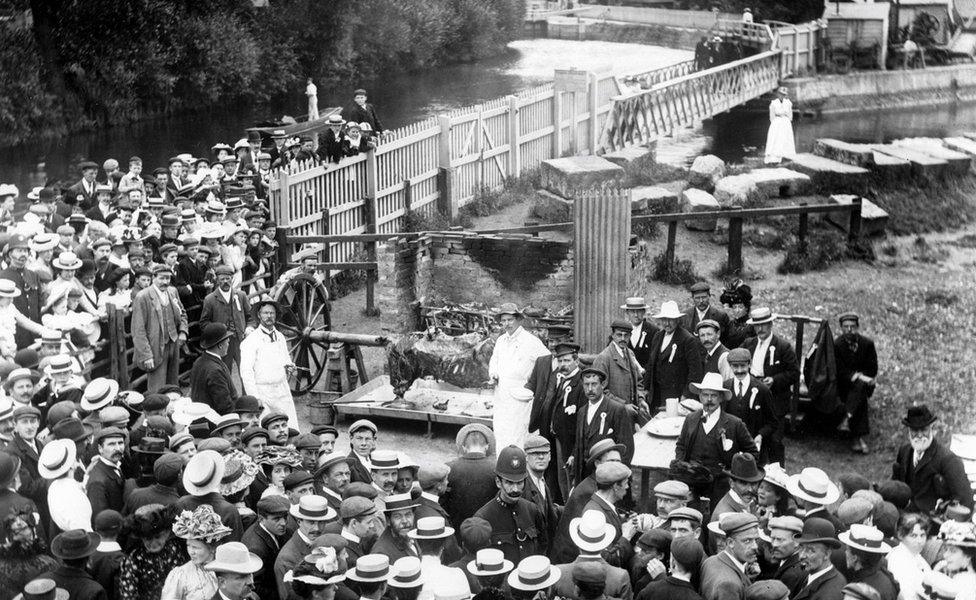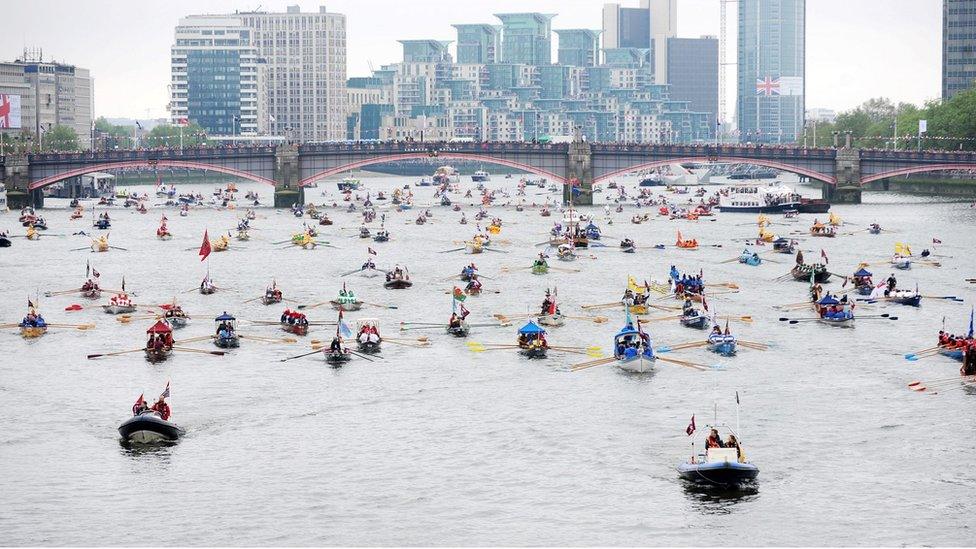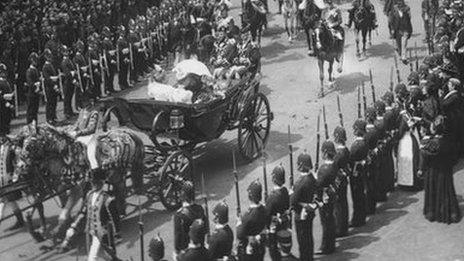Platinum Jubilee: How have we celebrated in the past?
- Published

The Queen's first jubilee year, in 1977, was celebrated with street parties across the country
The Platinum Jubilee celebrations marking the Queen's 70 years on the throne are the first of their kind - aside from Victoria, no other Queen or King of Great Britain has even reigned for 60 years.
Although many monarchs have at least reached the Silver Jubilee mark, the pomp we associate with such milestones is a relatively modern phenomenon.
The story of jubilee jubilation begins in London in the 19th Century.
George III

Decorations featuring George III's name and crowns were on display for the illuminations that lit up London
While two English kings, Henry III and Edward III, were on the throne for more than 50 years - their reigns came centuries before the creation of Great Britain - there is little evidence that these milestones were marked in any significant way.
In terms of a grand celebration, George III's Golden Jubilee is considered to be Britain's first large-scale jubilee knees-up.
The King and Royal Family marked the occasion with a private service and grand fete in Windsor, but the public celebration in London on 25 October 1809 - marking the beginning of the 50th year of his reign - was a much more boisterous affair.
Shops were shut, bells rang out and the Tower of London witnessed a 50-gun salute as huge numbers of people hit the streets dressed up in their finest.
Church services were held across the city, including one at St Paul's Cathedral, and a procession organised by the Lord Mayor and the Corporation of London headed through the city. Food and money were provided to the poor so they could take part in the festivities.
Cities, towns and villages around the country followed suit with communal celebrations often funded by wealthy landowners.

A bronze medal was produced to mark the end of the 50th year of George III's reign
The village of Nuneham Courtenay, in Oxfordshire, was said to have gone as far as to decree that any children born in the year of the Golden Jubilee should be christened either Jubilee George or Jubilee Charlotte (George's Queen).
In the capital, the day of the celebration was completed with fireworks and magnificent illuminations lighting up the buildings of the Square Mile.
Despite the grandeur, the Times decided to report the festivities in a reserved British way, remarking that the "happy event" had been "celebrated by all ranks of people in this great metropolis, in a manner worthy of an aged and venerable King".
Victoria

Queen Victoria took an open carriage to Westminster Abbey for a ceremony of thanksgiving in 1887
Taking the throne at the age of 18, Victoria celebrated two jubilees during her long reign.
First up was her Golden Jubilee in 1887. The Queen had by this point largely withdrawn from public life, so it was seen as a way for her to reconnect with the nation.
Celebrated on 20 and 21 June of that year, the occasion was first marked by Queen Victoria in Windsor near her beloved husband Prince Albert's mausoleum. Later, she arrived in London for a banquet at Buckingham Palace.

Following a parade and thanksgiving service, the Royal Family returned to the palace for another banquet and fireworks in the gardens
The following day Queen Victoria joined a procession through London's streets to Westminster Abbey and later returned to the palace, where she appeared on the balcony to the adulation of a large crowd.
A grand tea for some 30,000 London schoolchildren was held in Hyde Park, while processions and feasts took place across the country.

The people of Osney Bridge in Oxfordshire celebrated the Golden Jubilee by roasting an ox
Ten years later, Victoria became the first British monarch to celebrate a Diamond Jubilee, which proved to be an even grander affair.
In London, street feasts were laid on for 400,000 of the poorest residents, with free bottles of ale and pipe tobacco among the offerings. Pubs were allowed to remain open until 02:30, much to the dismay of the temperance movement.

Victoria found time to plant a tree in the grounds of Buckingham Palace during her Diamond Jubilee celebrations
Royals, dignitaries, and armed forces from across the British Empire led the Queen on a six-mile long procession through the capital, taking in the sights of Hyde Park Corner, the Strand and then across the Thames into parts of working-class Southwark.
Halfway through the parade, a short thanksgiving service took place outside St Paul's Cathedral. It had been decided the 78-year-old Queen, who suffered from arthritis, was too frail to climb the building's steps.
People crammed into the best spots along the route, packing pavements, perching on roofs and filling the odd specially built stand.

Special stands were erected along the Strand for people to watch the Diamond Jubilee procession
Among those watching from a rammed gantry in the Strand was the American writer Mark Twain, who described how "the sidewalks were filled with standing people" for the "stunning" procession, which had no "visible beginning or end".
When the Queen finally arrived in a carriage pulled by eight cream horses, "all the world rose to its feet" and "she was received with great enthusiasm".
"It was a memorable display, and must live in history," the author concluded.
George V

The residents of Dudley Street in Paddington had a right royal knees-up in 1935
In 1935 the driving test became compulsory in the UK, Alfred Hitchcock's The 39 Steps was released, and there was the first major celebration of a British monarch's Silver Jubilee.
When preparations were being made to commemorate George V's 25 years on the throne, the King declared he wanted to keep things local, so London once again took centre stage.
A bank holiday was declared for 6 May. As dawn broke on what was an unseasonably hot day, crowds were already lining the parade route between Buckingham Palace and St Paul's.

Some in the crowd resorted to holding mirrors above their heads to watch the 69-year-old monarch go past
Some of the people on the crammed pavements resorted to holding compact mirrors above their heads to catch sight of the Royal Family - adopting a pose reminiscent of that of today's selfie generation.
The heat and the moment proved too much for some spectators and they started to faint, with ambulance workers ferrying patients to the Blackfriars Cold Storage Company to revive them.
A service was held at St Paul's and, after the Royal Family returned to the palace, they made several appearances on the balcony. Among the royals present was a young Princess Elizabeth and her sister Margaret.

A footman eventually brought Princess Margaret a stool as she and her sister joined the King and Queen on the balcony
Away from the parade route, street parties were held beneath streams of flags and bunting, while celebrations took place at the city's restaurants and hotels which served up specially created jubilee cocktails and dishes.
Later that evening the capital's landmarks were illuminated with floodlights, and a huge firework display took place at the Crystal Palace in south-east London.

Dozens of tea parties for children were put on in London's streets
Celebrations weren't just held in the capital though.
Margaret Laishley, who now lives near Plymouth, was four years old at the time. She remembers her family taking a trip into the centre of Bristol from their home north of the city to take part in the festivities.
"The city was very, very prettily decorated with fairy lights and hanging baskets everywhere. I thought I was in fairy land," she said.
"It was quite the event for me as we actually went out. We didn't have a car and didn't go out much in those days."

Bunting and flags were plentiful
As life returned to normal the day after the bank holiday, a Times reporter - who quite possibly had a slight chip on his shoulder - basked in the triumph of the occasion.
"Who, after last night's scenes, can still maintain that we are a humdrum people, incapable of the light-heartedness of some other nations?" he proudly wrote.
Elizabeth II

The capital was given a spruce-up in preparation for the Silver Jubilee celebrations
The Queen, who is now only two years away from becoming the longest-serving monarch in world history, has already celebrated three major jubilees.
In 1977, royal visits were made across Great Britain and Northern Ireland, with 36 counties visited in three months, while the Queen and Prince Philip travelled some 56,000 miles to take in parts of the Commonwealth.

Forty-two years after appearing with her grandfather, the Queen was on the palace balcony for her own Silver Jubilee
The Silver Jubilee celebrations culminated in June in London, where the Queen was driven through the crowd-thronged capital in the gold state coach for a service of thanksgiving at St Paul's.
Her return along the Mall was estimated to have been watched by 500 million people on television. Street parties were widespread, with an estimated 4,000 reported to have taken place in the capital alone.

In 2002, the Queen and Prince Philip took the golden state carriage to St Paul's
The Queen's Golden Jubilee 25 years later saw another procession and more streets shut off for parties across the country.
The grounds of Buckingham Palace took on the look of a summer festival as some 12,000 people gathered in the gardens for the Prom at the Palace concert, external on 1 June.

Ozzy Osbourne and Kermit the Frog were among the eclectic mix of performers at Party at the Palace
Two days later came the Party at the Palace, external, where the Queen witnessed Sir Paul McCartney leading a Hey Jude singalong, Dame Shirley Bassey blasting out Goldfinger and, appropriately, the Queen guitarist Brian May strumming out the national anthem on the palace roof.
An estimated one million people filled the Mall to stare at large screens and take in the general merriment.

A flypast soared over the crowds on the Mall as the Royal Family stood on the palace balcony
Musicians were back on the palace roof for the Diamond Jubilee Concert 10 years later - this time Madness - although the riff-raff weren't allowed back in the gardens, with a huge stage instead being erected outside Buckingham Palace.
Sir Paul was back again as was Dame Shirley - this time belting out Diamonds are Forever - while Sir Elton John, Stevie Wonder and Kylie Minogue all performed too.

The residents of SW1 who'd planned a quiet night in on 4 June 2012 were probably not very happy
Over four days of celebrations across the UK, balcony appearances took place, St Paul's once again staged a thanksgiving service and the bunting was of course hung out for a multitude of street parties.
Perhaps most memorably, on a soggy Sunday one million rain-soaked people lined the banks of the River Thames to watch 1,000 boats sail past.

Boats taking part in the Thames River Pageant ranged from the Queen's barge to the humble kayak
In a message to nation, the Queen described the occasion as "a humbling experience", adding that she had been "deeply touched" by seeing so many people celebrating together.
These are sentiments the Queen has reiterated during this Platinum Jubilee weekend of parties, parades and processions - and, one hopes, a whole lot of pudding.
All images subject to copyright

Follow BBC London on Facebook, external, Twitter , externaland Instagram, external. Send your story ideas to hellobbclondon@bbc.co.uk
- Published11 September 2022

- Published2 June 2022

- Published10 January 2022

- Published22 May 2012
